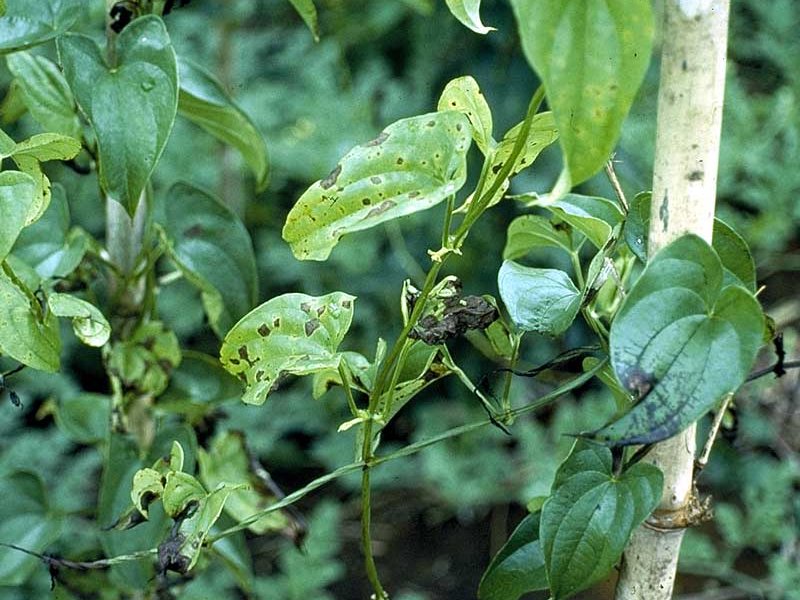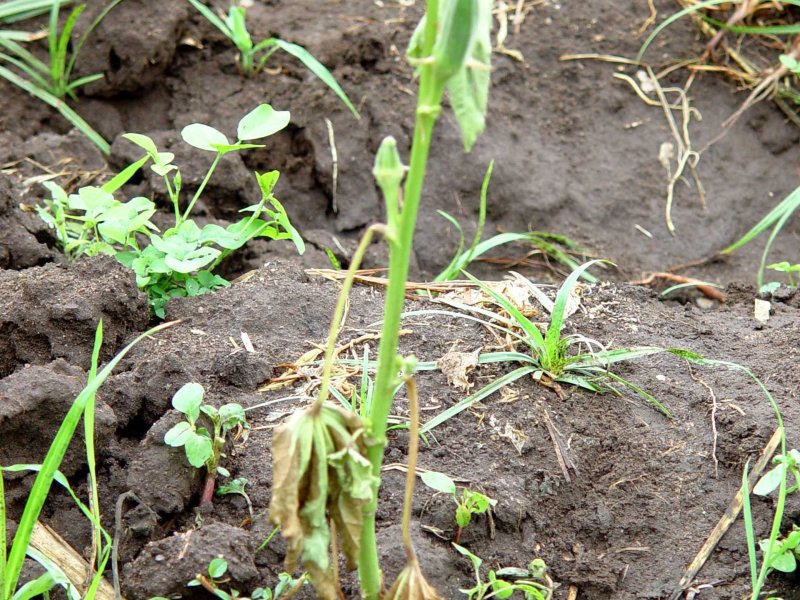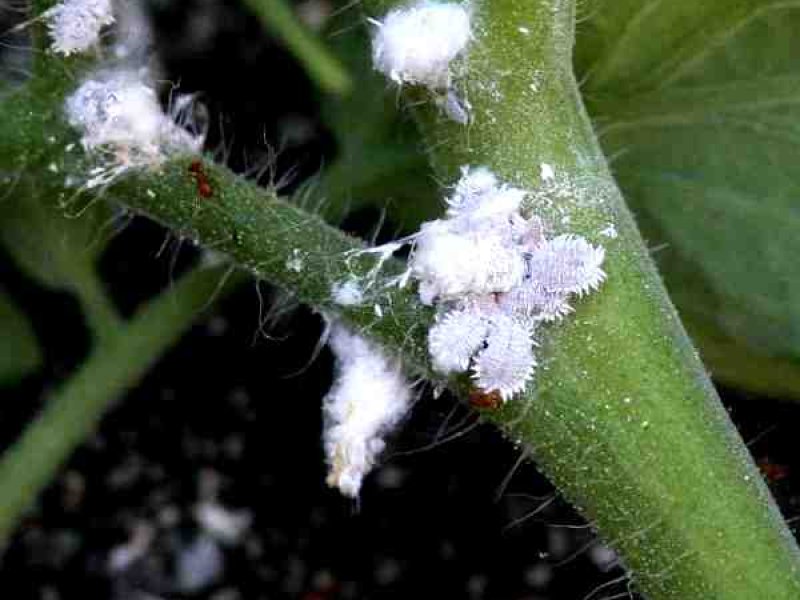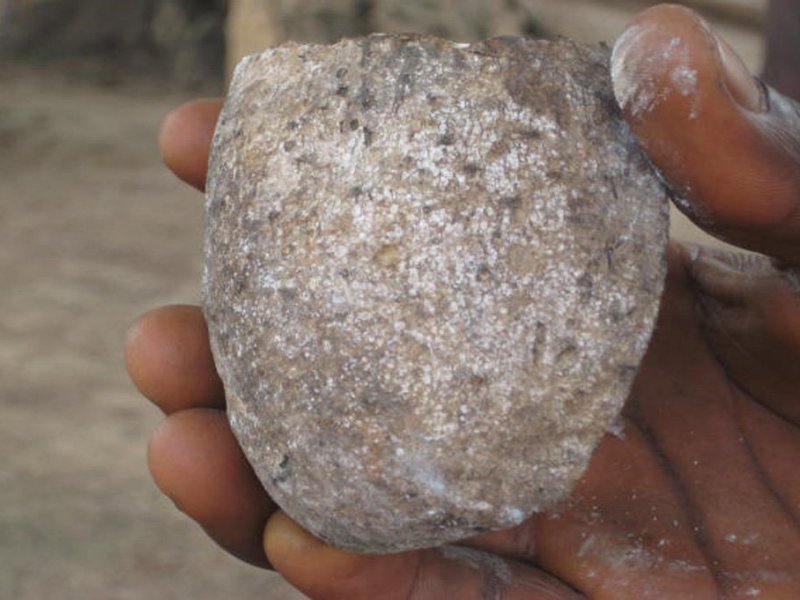|
Anthracnose (Glomerella cingulata) It is a serious disease which results in blackening and dieback of the leaves. The disease is more severe on white yam than in other edible yams.
|
|
|
What to do:
|
|
Fusarium wilt (Fusarium spp.) Fusarium wilt and other tuber rots afflict white yam tubers, especially in storage.
|
|
|
What to do:
|
|
Greater yam beetle (Heteroligus meles) Heteroligus meles is widespread in tropical Africa. It attacks the tubers. Adult beetles eat the planting setts and plants may wilt and die. The holes in tubers reduce market value.
Adult beetles are 23-33 mm long, dark brown to black, with 2 prominent knobs on the head. The beetles lay eggs in the soil close to river banks and these hatch to produce creamy-white to grey larvae, which feed on grass roots and other organic matter. From egg to adult takes 22-24 weeks and emergence coincides with the beginning of the rains and the planting of yams. Further attack occurs just before harvest when the beetles again feed voraciously and then migrate to the breeding sites. |
|
|
What to do:
|
|
Mealybugs (Rastrococcus spp.) Mealybugs are small, flat, soft bodied insects covered with a distinctive segmentation. Their body is covered with a white woolly secretion. They suck sap from tender leaves, petioles and fruits. Seriously attacked leaves turn yellow and eventually dry. This can lead to shedding of leaves, inflorescences, and young fruit. Mealybugs excrete honeydew on which sooty mould developed. Heavy coating with honeydew blackens the leaves, branches and fruit. This reduces photosynthesis, can cause leaf drop and affect the market value of the fruit.
A wide range of natural enemies attacks mealybugs. The most important are ladybird beetles, hover flies, lacewings, and parasitic wasps. These natural enemies usually control mealybugs. However, mealybugs can cause economic damage to mango when natural enemies are disturbed (for instance by ants feeding on honeydew produced by mealybugs or other insects) or killed by broad-spectrum pesticides, or when mealybugs are introduced to new areas, where there are no efficient natural enemies.
The latter is the case of two serious mealybug pests on mangoes in Africa: Rastrococcus invadens in West and Central Africa and Rastrococcus iceryoides in East Africa. These mealybugs, of Asian origin, were introduced into Africa, where they developed into serious pests since the natural enemies present were not able to control them. They cause shedding of leaves, inflorescences and young fruits. In addition, sooty moulds growing on honeydews excreted by the insects render the fruits unmarketable and the trees unsuitable for shading. They cause direct damage to fruits leading to 40 to 80% losses depending on locality, variety and season. Rastrococcus invadens was brought under control in West and Central Africa by two parasitic wasps (Gyranusoidea tebygi and Anagyrus mangicola) introduced from India (Neuenschwander, 2003).
Rastrococcus iceryoides is a major pest of mango in East Africa, mainly Tanzania and coastal Kenya. Although several natural enemies are known to attack this mealybug in its aboriginal home of southern Asia (Tandon and Lal, 1978; CABI, 2000), none have been introduced so far into Africa (ICIPE). Insecticides do not generally provide adequate control of mealybugs owing to their wax coating. |
|
|
What to do:
|
|
Yam scale (Aspidiella hartii) Infestations of tubers and sometimes foliage cause poor growth. Stored tubers are particularly susceptible to attack and large numbers cause shrivelling.
Adult female scales are pinkish-brown, roughly oyster-shaped, conical, with a white patch at the tip of the cone. Younger scales are relatively more white. Crawlers are yellow. |
|
|
What to do:
|
Geographical Distribution in Africa
Geographical distribution of Yam in Africa. Updated 28 November 2018. Source www.cabi.org.
General Information and Agronomic Aspects
White Yam is native to Southeast Asia and is grown in practically all parts of the tropics where it except in parts of Africa, it is the predominant kind of yam.
West Africa is the most important area for yam production in the world. Over 90% of global yam production comes from this region. Nigeria alone produces about 68% of the world's yams, followed by Cote d'Ivoire, Benin, Ghana and Togo. Within West Africa, production occurs in the northern forest and southern savanna zones. Further north, the rainy season is too short, and further south the soils are waterlogged and there is too much cloud cover for economical yam production.
Elsewhere in Africa and in the rest of the tropics, the white yam (water yam) is the dominant yam species. Significant quantities are produced in Democratic Republic of Congo, Ethiopia, the Central African Republic and Sudan.
Yam is a preferred food security crop in the drier areas of Kenya. One plant is reported to be able to produce 1 full 90 kg bag of tubers, which can be harvested a few at the time for home consumption or sold in the market for a good price. Many families in Kenya plant yam near the trees in the shamba (farm), so they can get support for climbing vines.
The tubers and larger bulbils of white yam are consumed as a starchy staple, after cooking in various ways. They can be processed into yam flakes or yam flour. Their use as a source of starch is minor.
Nutritive Value per 100 g of edible Portion
| Raw or Cooked Yam | Food Energy (Calories / %Daily Value*) |
Carbohydrates (g / %DV) |
Fat (g / %DV) |
Protein (g / %DV) |
Calcium (g / %DV) |
Phosphorus (mg / %DV) |
Iron (mg / %DV) |
Potassium (mg / %DV) |
Vitamin A (I.U) |
Vitamin C (I.U) |
Vitamin B 6 (I.U) |
Vitamin B 12 (I.U) |
Thiamine (mg / %DV) |
Riboflavin (mg / %DV) |
Ash (g / %DV) |
| Yam cooked | 116 / 6% | 27.5 / 9% | 0.1 / 0% | 1.5 / 3% | 14.0 / 1% | 49.0 / 5% | 0.5 / 3% | 670 / 19% | 122 IU / 2% | 12.1 / 20% | 0.2 / 11% | 0.0 / 0% | 0.1 / 6% | 0.0 / 2% | 0.8 |
| Yam raw | 118 / 6% | 27.9 / 9% | 0.2 / 0% | 1.5 / 3% | 17.0 / 2% | 55.0 / 6% | 0.5 / 3% | 816 / 23% | 138 IU / 3% | 17.1 / 28% | 0.3 / 15% | 0.0 / 0% | 0.1 / 7% | 0.0 / 2% | 0.8 |
*Percent Daily Values (DV) are based on a 2000 calorie diet. Your daily values may be higher or lower, depending on your calorie needs.
Climate conditions, soil and water management
White yam is a plant of the subhumid to humid tropics but also does well in semi-arid regions, in fairly light soils. Reported temperature range for growth is 14-40°C with the optimum between 20-32°C or 25-30°C. The growth is considerably retarded at temperatures below 20°C.
Since it requires 7-10 months to mature in the field, it is essential that the rainy season lasts at least as long, unless supplementary irrigation can be provided. A well-distributed rainfall (or water supply) of 1500 mm per annum is adequate for yam production. However, dry spells of up to 1 month during the growing season do not severely reduce yields. It is occasionally grown in high rainfall areas in East Africa. Reported annual rainfall range for growth is 700-8000 mm with the optimum between 1200-4000 mm.
It is mostly a crop of the lowlands, though it occurs at elevations of up to 2500 m (in India). It tolerates poorer soils than most other cultivated yams. White yam is sensitive to aluminium toxicity in the soil.
It thrives in deep, fertile, well drained, loose, loams and sandy-loam soils with low levels of salinity. It responds well to manuring. However, compared with other tropical tuber crops, yams require soil of high fertility. Heavy clays tend to be waterlogged and result in tuber rots and difficult harvesting. Gravel or rocky soils tend to hinder tuber penetration. Reported soil pH range for growth is 4.8-8.5 with the optimum between 5.5-6.5.
Propagation and planting
Tuber dormancy lasts for 2-4 months after harvest. Small intact tubers ("seed tubers") or tuber pieces weighing 50-500 g are used for planting on mounds, ridges, or on the flat. Intercropping is the most common practice, with the distance between yam plants determined by the number and types of the other crops in the field. Where sole cropping is done, rows are 1 m apart, with intra-row spacing of 50-100 cm.
Yam cultivars grown in Kenya are Baribate; Barimutwa; Kambo; Karukwaji; Kijara; Kimwere; Majara; Mbeu Iguru; Mbeu mpuria; Mbeu nkuru; Mbeu ruguru; Mbeuku; Mbithi; Murijo; Murungwa; Mweru; Mwezi I; Mwimba Iguru; Nakirima; Nalo; Ndera ngutu; Ndiathi; Ndiua na thi; Ngundu; Nkandau; Nkone; Ntigania; Ntokinyoni; Nyaara, Emondo, Embame and Kihama among others.
Husbandry
Plants are usually staked soon after emergence. Unstaked cultivation, which suppresses weeds better but gives lower yields, is also practised. Weeding is done 3-4 times during the season, using hand tools. In general, yam is the first crop in the rotation after fallow.
Harvesting
Harvesting occurs 7-10 months after planting. Hand tools are used to dig up the tubers. Although the tubers can be kept quite well, they are easily damaged during and after harvest, and must be handled carefully to avoid bruises. They are stored in cool shady conditions. Tubers can be processed into yam flakes or yam flour, or marketed fresh.
Information on Pests
The greater yam beetle (Heteroligus meles) attacks the tubers. Adult beetles eat the planting setts and plants may wilt and die. The holes in tubers reduce market value.Scale insects and mealybugs may infest the tubers, especially during storage.
Nematodes attack the plant, resulting in warty appearance of the tuber.
Wild animals such as pigs and rodents may destroy the crop in some locations.
| Greater yam beetle (Heteroligus meles) Heteroligus meles is widespread in tropical Africa. It attacks the tubers. Adult beetles eat the planting setts and plants may wilt and die. The holes in tubers reduce market value.
Adult beetles are 23-33 mm long, dark brown to black, with 2 prominent knobs on the head. The beetles lay eggs in the soil close to river banks and these hatch to produce creamy-white to grey larvae, which feed on grass roots and other organic matter. From egg to adult takes 22-24 weeks and emergence coincides with the beginning of the rains and the planting of yams. Further attack occurs just before harvest when the beetles again feed voraciously and then migrate to the breeding sites. What to do:
|
| Infestations of tubers and sometimes foliage cause poor growth. Stored tubers are particularly susceptible to attack and large numbers cause shrivelling.
Adult female scales are pinkish-brown, roughly oyster-shaped, conical, with a white patch at the tip of the cone. Younger scales are relatively more white. Crawlers are yellow. What to do:
|
| Mealybugs are small, flat, soft bodied insects covered with a distinctive segmentation. Their body is covered with a white woolly secretion. They suck sap from tender leaves, petioles and fruits. Seriously attacked leaves turn yellow and eventually dry. This can lead to shedding of leaves, inflorescences, and young fruit. Mealybugs excrete honeydew on which sooty mould developed. Heavy coating with honeydew blackens the leaves, branches and fruit. This reduces photosynthesis, can cause leaf drop and affect the market value of the fruit.
A wide range of natural enemies attacks mealybugs. The most important are ladybird beetles, hover flies, lacewings, and parasitic wasps. These natural enemies usually control mealybugs. However, mealybugs can cause economic damage to mango when natural enemies are disturbed (for instance by ants feeding on honeydew produced by mealybugs or other insects) or killed by broad-spectrum pesticides, or when mealybugs are introduced to new areas, where there are no efficient natural enemies.
The latter is the case of two serious mealybug pests on mangoes in Africa: Rastrococcus invadens in West and Central Africa and Rastrococcus iceryoides in East Africa. These mealybugs, of Asian origin, were introduced into Africa, where they developed into serious pests since the natural enemies present were not able to control them. They cause shedding of leaves, inflorescences and young fruits. In addition, sooty moulds growing on honeydews excreted by the insects render the fruits unmarketable and the trees unsuitable for shading. They cause direct damage to fruits leading to 40 to 80% losses depending on locality, variety and season. Rastrococcus invadens was brought under control in West and Central Africa by two parasitic wasps (Gyranusoidea tebygi and Anagyrus mangicola) introduced from India (Neuenschwander, 2003).
Rastrococcus iceryoides is a major pest of mango in East Africa, mainly Tanzania and coastal Kenya. Although several natural enemies are known to attack this mealybug in its aboriginal home of southern Asia (Tandon and Lal, 1978; CABI, 2000), none have been introduced so far into Africa (ICIPE). Insecticides do not generally provide adequate control of mealybugs owing to their wax coating. What to do:
|
| Anthracnose (Glomerella cingulata) It is a serious disease which results in blackening and dieback of the leaves. The disease is more severe on white yam than in other edible yams.
What to do:
|
Information Source Links
- A.A. Brunt, G.V.H. Jackson and E.A. Frison, FAO/IBPGR Technical guidelines for the safe movement of yam germplasm. www.citeseerx.ist.psu.edu
- CAB International (2005). Crop Protection Compendium, 2005 edition. Wallingford, UK www.cabi.org
- CABI
- Estimation of genetic diversity of Kenyan Yam (Dioscorea spp.) using microsatellite markers. Muthamia, Z. K.; Morag, F. E.; Nyende, A. B.; Mamati, E. G.; Wanjala, B. W. 2009.www.jkuat.ac.ke
- Nutrition Data www.nutritiondata.com.
- OISAT: Organisation for Non-Chemical Pest Management in the Tropics. www.oisat.org




